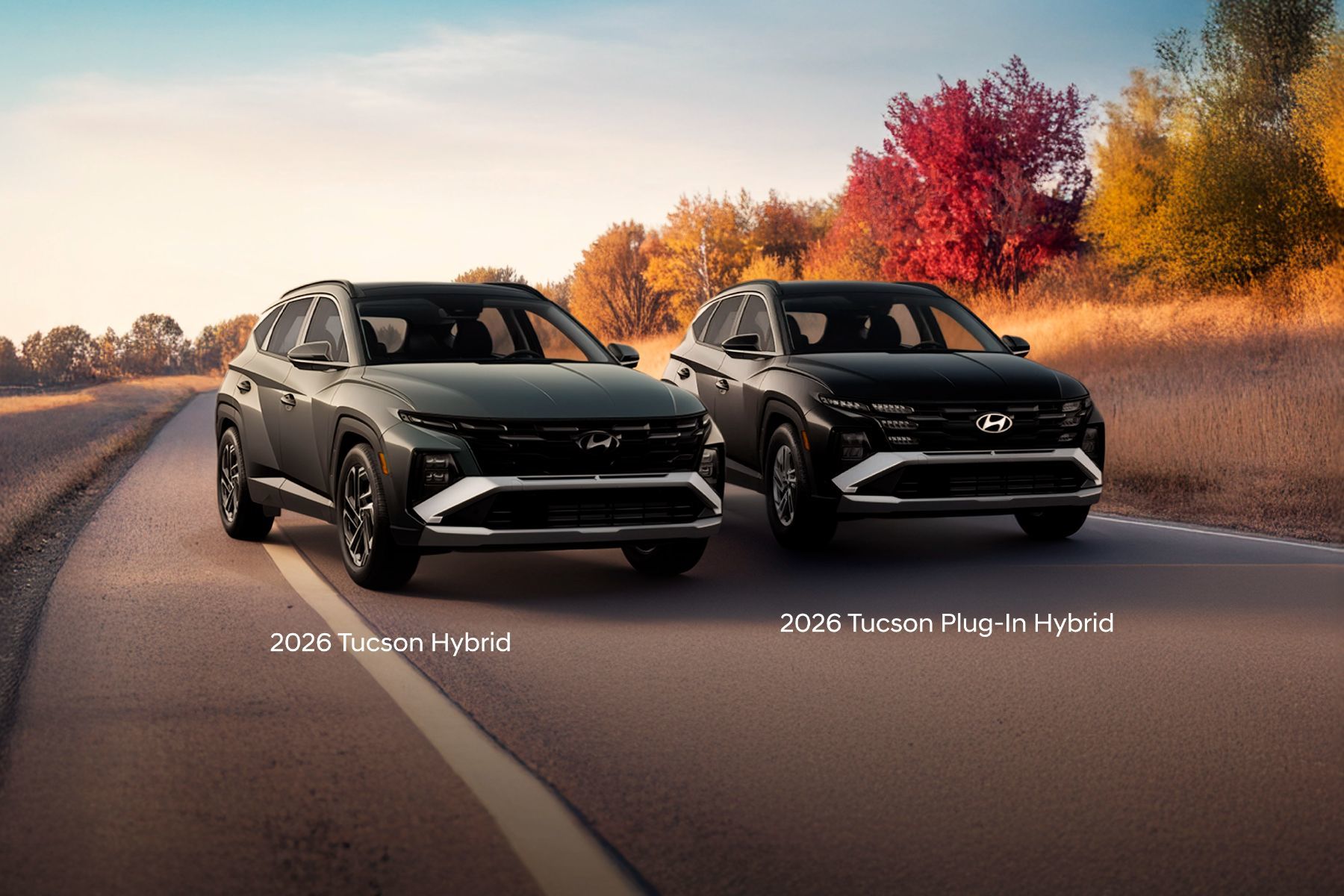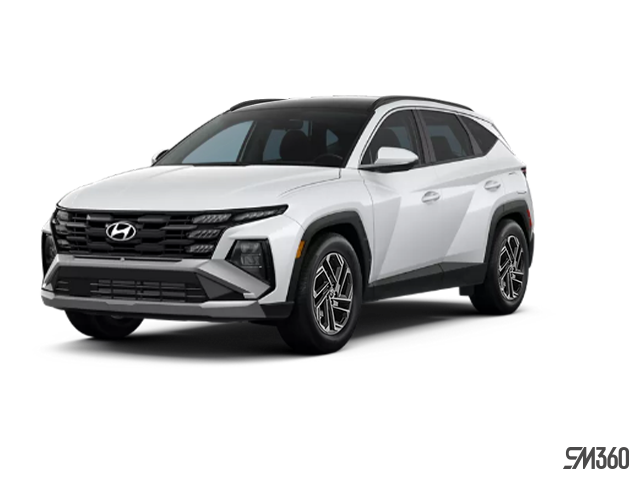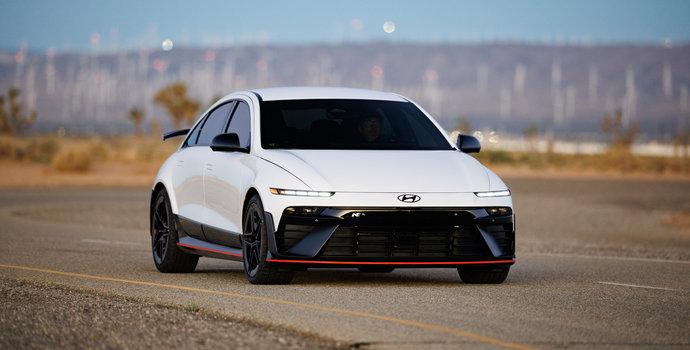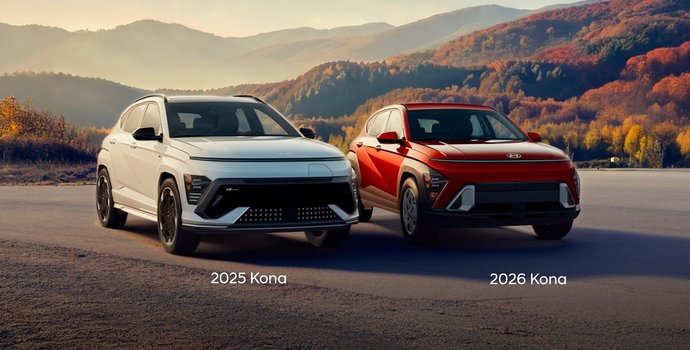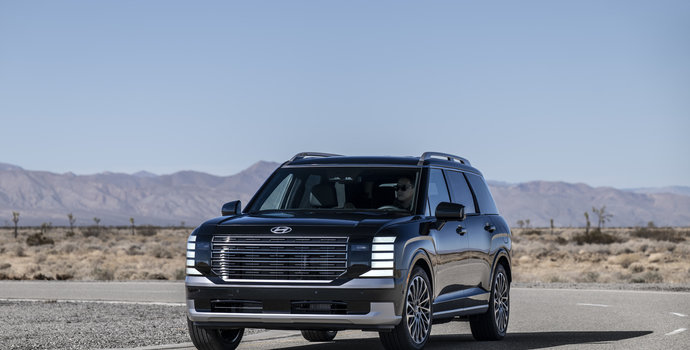Overview
If you’re an Ontario driver looking to cut fuel costs and shrink your carbon footprint, Hyundai’s 2026 Tucson lineup gives you two smart choices: the Hybrid N-Line and the Plug-In Hybrid (PHEV) Ultimate. Both deliver all-wheel-drive confidence, impressive tech, and everyday practicality, but the real question is: how much electric driving do you want?
For commuters tackling the 401 daily or families making weekend cottage trips, these two versions approach efficiency in different ways. The Hybrid seamlessly switches between and combines gas and electric power for long-distance versatility, while the Plug-In Hybrid lets you drive short distances purely on electric power before the gas engine takes over.
The difference comes down to charging habits, range preferences, and how you use your SUV day-to-day. Let’s break it all down clearly — no guesswork required.
Quick Comparison: 2026 Tucson Hybrid vs Plug-In Hybrid
Here’s a side-by-side of the key highlights pulled directly from Hyundai’s latest specs:
|
Feature
|
Tucson Hybrid N-Line
|
Tucson Plug-In Hybrid Ultimate
|
|
Engine
|
1.6L Turbo GDI Hybrid
|
1.6L Turbo GDI Plug-In Hybrid
|
|
Transmission
|
6-speed automatic
|
6-speed automatic
|
|
Drive System
|
HTRAC All-Wheel Drive
|
HTRAC All-Wheel Drive
|
|
Fuel/Energy Source
|
Gas + Regenerative Electric
|
Gas + Rechargeable Electric Battery
|
|
Electric Range
|
N/A (Self-charging system)
|
Up to 50–55 km (estimated electric-only range)
|
|
Charging
|
None required
|
Plug-in charging (home or Level 2 station)
|
|
Infotainment
|
12.3" Display with HD Radio
|
12.3" Display with Navigation, HD Radio
|
|
Interior Highlights
|
Sport accents, red stitching
|
Memory driver’s seat and side mirrors
|
|
Safety
|
Forward Collision-Avoidance Assist, Lane Keeping Assist, Lane Following Assist
|
Adds Blind View Monitor, Remote Smart Parking Assist, Surround View Monitor
|
|
Fuel Savings Potential
|
Moderate: hybrid assist during all drives
|
High: all-electric mode for local trips
|
|
Usability Focus
|
No charging, fully self-sufficient
|
Ideal for short commutes and EV-friendly households
|
Performance and Range: Everyday Efficiency vs Electric Flexibility
Both Tucsons share Hyundai’s 1.6L Turbo GDI engine and HTRAC all-wheel drive system, meaning you get strong traction for Ontario winters and solid acceleration when merging onto the 401.
The Hybrid N-Line delivers efficiency without any need to plug in. It uses regenerative braking and the onboard battery to assist the gas engine automatically, saving fuel on every trip — whether you’re heading to Toronto for work or running errands in Woodstock.
The Plug-In Hybrid, on the other hand, lets you start each morning fully charged and drive purely electric for your daily commute. Many Ontario drivers find they can handle most weekday trips without using a drop of fuel. And when longer journeys call, the gas engine kicks in seamlessly, offering full hybrid performance without range anxiety.
In short:
- Hybrid = less fuel, zero charging effort
- Plug-In = near-zero fuel for short trips, plus hybrid flexibility for road trips
Charging and Convenience
If home charging is an option, the Tucson PHEV adds a layer of savings and quiet comfort that’s hard to beat. Plug it into a 240V Level 2 charger, and the battery can top up in about two hours — perfect for overnight charging in your driveway or garage.
The Hybrid N-Line, however, remains the simpler choice for drivers who don’t have a charging setup or live in condos where charging isn’t convenient. You still benefit from electric assist — just without plugging in.
Both models come equipped with BlueLink Connected Vehicle System, wireless Apple CarPlay and Android Auto, and Bose premium audio, ensuring that even your most eco-friendly drive still feels high-tech and engaging.
Fuel Savings and Ownership Experience
Fuel savings depend on your driving pattern. If you do mostly highway driving, the Hybrid keeps things efficient without lifestyle changes. But for shorter, stop-and-go city drives — where hybrids often shine — the PHEV wins big by using its electric motor alone.
Many eco-conscious drivers find that charging a plug-in hybrid costs less than a few cups of coffee per week in electricity, while still offering the flexibility to take road trips without planning around chargers.
Both vehicles qualify under Hyundai’s comprehensive warranty and are supported by HTRAC AWD, so you’re getting long-term confidence whichever route you take.
Interior and Tech: N-Line Energy vs Ultimate Comfort
Inside, both Tucsons share a premium, tech-focused cabin — but with distinct personalities.
The Hybrid N-Line adds a sporty feel with suede-and-leather seats, aluminum pedals, and bold red stitching that makes every drive a little more exciting. Perfect for drivers who want eco-performance with flair.
The Plug-In Hybrid Ultimate leans toward sophistication: full leather seats, and a driver’s seat and side mirror memory system allow you to easily adjust for optimal comfort, no matter who’s driving.
Both versions feature 12.3” digital displays, wireless charging pads, and advanced climate control. You’ll also find Hyundai’s Digital Key 2, letting you unlock and start your Tucson with your smartphone.
Safety and Driver Assistance
Each Tucson includes Hyundai’s SmartSense suite, with must-have systems like Forward Collision-Avoidance Assist, Lane Keeping Assist, and Adaptive Cruise Control with stop-and-go.
Where the Plug-In Hybrid Ultimate pulls ahead is in its advanced assist tech — offering Surround View Monitor, Remote Smart Parking Assist, and Blind View Monitor, providing an extra layer of reassurance when navigating city parking lots or reversing out of tight spaces.
Key Takeaways
If you want a no-fuss, fuel-saving SUV, the 2026 Tucson Hybrid N-Line hits the sweet spot — efficient, fun to drive, and ideal for longer commutes.
If you’re ready to plug in and drive most days on electric power, the 2026 Tucson Plug-In Hybrid Ultimate rewards you with quieter drives, more EV mileage, and even greater long-term fuel savings.
Both offer the same confident AWD system and Hyundai reliability. The decision comes down to your routine:
- No charger, long drives? Go Hybrid.
- Short commutes, home charging? Go Plug-In.
Either way, you’re driving smarter — and greener.
FAQ: 2026 Hyundai Tucson Hybrid vs Plug-In Hybrid
Q: Do I need special equipment to charge the Plug-In Hybrid?
A: A standard household outlet works, but a Level 2 charger dramatically speeds things up, fully charging in around two hours.
Q: Can the Plug-In Hybrid drive without gas?
A: Yes, it can drive purely on electric power for short trips, then seamlessly switch to hybrid mode when needed.
Q: Is there a big difference in maintenance?
A: Both have similar service intervals. The PHEV’s battery system requires no regular maintenance beyond periodic inspections.
Q: Which model is better for winter driving in Ontario?
A: Both feature HTRAC All-Wheel Drive and Hyundai’s Multi-Terrain Modes (Snow, Mud, Sand) — giving you peace of mind in slippery conditions.
Conclusion
At the end of the day, the 2026 Hyundai Tucson proves that efficiency doesn’t mean compromise. Whether you choose the Hybrid N-Line for effortless fuel savings or the Plug-In Hybrid Ultimate for more electric freedom, both versions deliver the tech, comfort, and all-weather performance Ontario drivers value.
What it really comes down to is your lifestyle. If plugging in fits your routine, the PHEV gives you the quietest, cleanest drive Hyundai offers today. If you’d rather skip the cord and keep things simple, the Hybrid delivers excellent mileage on its own.
Either way — you’ll drive away confident you’ve made a smart, sustainable choice.
You might also be interested in these blogs:


